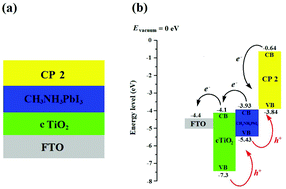The photocurrent response in the perovskite device based on coordination polymers: structure, topology, band gap and matched energy levels†
Abstract
Using a rigid ditopic ligand, 4,5-di(4′-carboxylphenyl)benzene (H2L), three coordination polymers (CPs) formulated as MnL(H2O)2 (1), CdL(H2O) (2) and Mn2L2(DMF)3 (3) have been synthesized and structurally characterized by single-crystal X-ray diffraction. These three CPs display 2D architectures but with different topologies. The experimental data and DFT calculation indicate that CP 2 is a semiconductor, and its CB/VB energy levels match with those of the perovskite CH3NH3PbI3. A FTO/TiO2/CH3NH3PbI3/CP 2 device is fabricated and the CP-based device shows much larger photoresponse under visible light illumination (650 nm > λ > 350 nm, 100 mW cm−2) than the individual CP 2. At 0 V vs. AgCl/Ag, the largest photocurrent density yielded by the CP-based perovskite device is ca. 200 times that of CP 2, which is due to the matched energy levels of all the materials in the device, leading the photogenerated electron–hole pairs to be separated effectively. Meanwhile, the coverage of the insoluble CP on the surface of the perovskite CH3NH3PbI3 can improve the stability of the perovskite against water.



 Please wait while we load your content...
Please wait while we load your content...